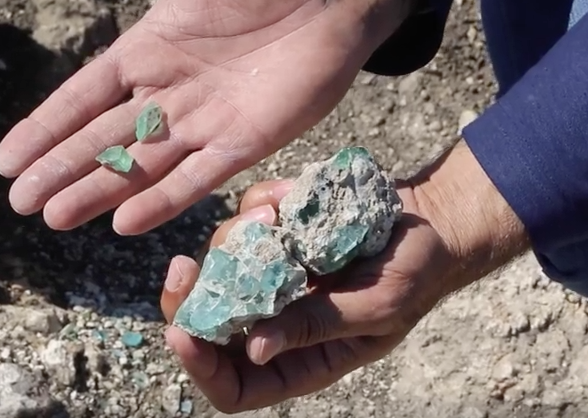
[Image above] An archaeologist holds pieces of ancient raw glass uncovered during an excavation in Israel that uncovered 1,600-year-old kilns capable of producing commercial quantities of glass for the ancient world. Credit: Sh Yoli; YouTube
A recent excavation uncovered remains of the oldest kilns in Israel, where archaeologists believe commercial quantities of raw glass were produced 1,600 years ago—a discovery that proves Israel was one of the largest glass producers in the ancient world, the Israel Antiquities Authority reports.
The discovery occurred during the Jezreel Valley Railway Project, a long-term, multi-disciplinary survey and excavation project investigating the history of human activity in the Jezreel Valley from the Paleolithic through the Ottoman period.
The structure of the ancient kilns contained two compartments—a firebox used to burn kindling to create very high temperatures, and a melting chamber where the raw materials for the glass (such as clean beach sand and salt) were melted together at 1,200°C.
“This is a very important discovery with implications regarding the history of the glass industry both in Israel and in the entire ancient world,” Yael Gorin-Rosen, head curator of the Israel Antiquities Authority Glass Department, says in the report.
“We know from historical sources dating to the Roman period that the Valley of ‘Akko was renowned for the excellent quality sand located there, which was highly suitable for the manufacture of glass,” she adds. “Chemical analyses conducted on glass vessels from this period, which were discovered until now at sites in Europe and in shipwrecks in the Mediterranean basin, have shown that the source of the glass is from our region. Now, for the first time, the kilns have been found where the raw material was manufactured that was used to produce this glassware.”
Check out this video to learn more about the discovery.
Credit: Sh Yoli; YouTube
And if you’re interested in more of the latest ancient glass research and discoveries, make sure check out the May issue of the ACerS Bulletin, hitting mailboxes and inboxes soon.
The May cover story is “Ensuring longevity: Ancient glasses help predict durability of vitrified nuclear waste,” a piece about how ancient glass artifacts provide a rich source of analogues to study new glasses for nuclear waste disposal.
